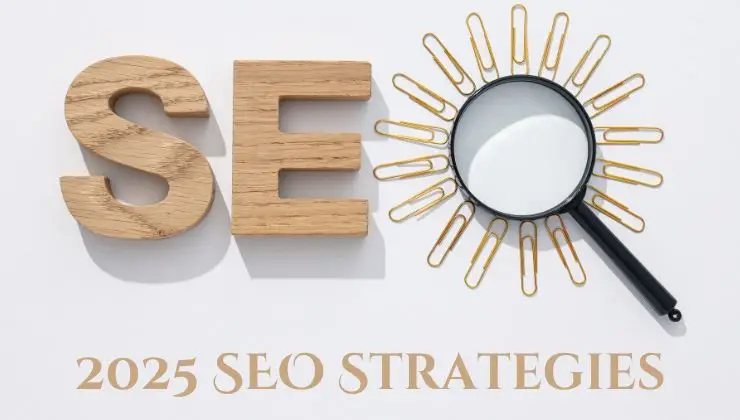How to create an SEO strategy that will give you results. Based on experience and on what works to rank in search engines like Google. Your ultimate goal should be to appear first in searches related to your niche.
SEO is a long-term task and therefore requires a strategic vision. If we coordinate our efforts well, we will see results much faster and we will also be able to maintain them over time.
Best SEO Strategy to Rank Your Website on Search Engine
SEO strategies are not only about optimizing your website but also require preparing before performing and being able to look to the future. Let’s look at it step by step.

1. Analyze the Competition
Ranking on Google is always relative since other pages are competing for the same keywords as us. Therefore, to plan the SEO strategy, we have to be aware of what the competition is doing.
Therefore, in this step, we will have to make a list of our main competitors and see for which keywords they are ranking their websites. My recommendation is that you rely on tools such as Semrush, Ahrefs, or MOZ, with which you can obtain a lot of information just by entering the URL of your competitor’s site.
2. Research your Keywords
Keyword analysis is the foundation on which the entire SEO strategy is based. To organize it, it is a good idea to start by obtaining a broad list of keywords (through brainstorming and tools such as Google Keyword Planner or Ubersuggest) and then try to narrow it down by seeing which ones interest us the most.
When making a final list, be sure to rule out these 3 types:
- Keywords with too much competition. We need to be aware of the resources we have. If a keyword is very attractive, but the entire first page is occupied by very strong sites, it is better to look for alternative options.
- Keywords that attract the wrong users. We always have to look at the intention behind a search term. If the person searching for that term is not interested in what you offer, there is no point in being in the first place.
- Keywords with very few searches. It is true that long-tail keywords can bring us good conversion data because they are very specific, but we have to set a threshold below which it is not worth optimizing for that word.
3. Get your Tools Ready
Many SEO tools can make this task easier, and throughout this article, we will mention the most important ones. But in particular, before starting, my recommendation is that you open an account in Google Console and link it to your Analytics account.
Google Console is a super useful tool to get information about the keywords that drive traffic to your website and correct any possible errors. By connecting both platforms, you can see all the information from Analytics and have everything under control.
4. Prepare your Page for Mobile Devices
For Google’s algorithm, the mobile version of your website is the primary one, and not the other way around.
Nowadays, the majority of search traffic comes from mobile devices, so your website must be properly optimized for them. To do this, it is recommended to either implement a responsive design throughout the page or use AMP (Accelerated Mobile Pages) technology.
5. Improve Loading Speed
The loading speed of a website is a determining factor for its ranking and also has a huge influence on the user experience. A website that takes too long to load frustrates visitors and is doomed to failure.
To optimize the loading of your website, we recommend that you take a look at Google PageSpeed Insights. With this tool, you can see a speed and optimization score and receive advice on how to improve them.
6. Optimize URLs
Optimized URLs make it easy for both users and search engines. The advice is to keep them as simple as possible (e.g. www.mywebsite.com/word) and contain the keywords you want to rank for.
On a more technical level, you need to be very careful with both duplicate URLs (for example, it is common to have several different URLs for the home page of a website) and redirects. The cleaner and clearer the structure of the website, the better.
7. Use Headers Correctly
Headings ( H1, H2, H3) are HTML tags that indicate the structure of a web page. They can be used to divide the text into different sections so that it is clear both for users (through different text sizes) and for search engines.
The most important heading is the H1, which indicates the title of the page. It should always be descriptive and include keywords, and we should only use one per page.
To divide the text into sections and subsections, it is recommended to use secondary headings (H2, H3, etc.). We can even go as far as H6 if necessary.
8. Optimize Titles, Descriptions and Images
In SEO strategy, details are very important.
Every page on your site should have an optimized title and description, as this is what will be displayed to users in search engine results pages.
As for images, they should at least have a text for the ALT tag (the description that is displayed when the image cannot be loaded) and be optimized to take a short time to load.
To keep all these aspects under control, it is recommended to use a specific tool, for example, the Yoast SEO WordPress plugin.
9. Create Quality Content
Quality content is the foundation not only of SEO strategy but of inbound and digital marketing in general.
I know we repeat this message to the point of exhaustion, and it’s not to be boring, but because it’s the truth. Google updates its algorithms almost daily, it’s not like it used to do it a few times a year. So if you don’t want to see your traffic fluctuate like the tides, you must provide valuable content that will keep your audience on your website. If you achieve this, your ranking will be constant over time and you will rise to the top organic search rankings. And the updates will hardly affect you.
Sometimes you can make the mistake of over-optimizing your content for search engines, even resorting to black hat SEO techniques. But in the long term, it is always worth thinking about the user first and creating content that is useful to them and answers their questions and needs.
10. Optimize for Voice Searches
Voice searches are a growing trend that forces us to rethink our SEO strategy. With Google Assistant, Siri, Alexa, and other similar technologies, user search behavior is quite different. In general, voice searches are longer, more “long tail” and more immediate, requiring short and direct answers.





